13B-REW stock dynosheet compared to stock dynosheets of other turbo engines
#1
13B-REW stock dynosheet compared to stock dynosheets of other turbo engines
It's important to understand the 13B-REW rotary engine in a larger context of turbocharged engines. In working stock form, how does it compare to previous turbo rotaries--what did Mazda achieve? How does it compare to modern turbo engines?
In another thread t-von posted this dynosheet (presumably from a dynojet roller dyno) he found of a stock series 6 FD. The stock FD is in red.

So let's first compare to earlier turbo rotaries. This dynosheet shows the series 3 turbo 12A engine output with the original and revised single scroll turbocharger:
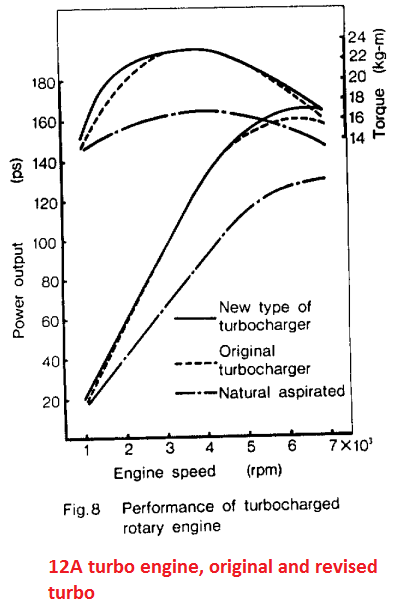
And here's the series 5 Rx-7 13B turbo engine with a twin scroll single turbo. This engine was the immediate predecessor to the 13B-REW.
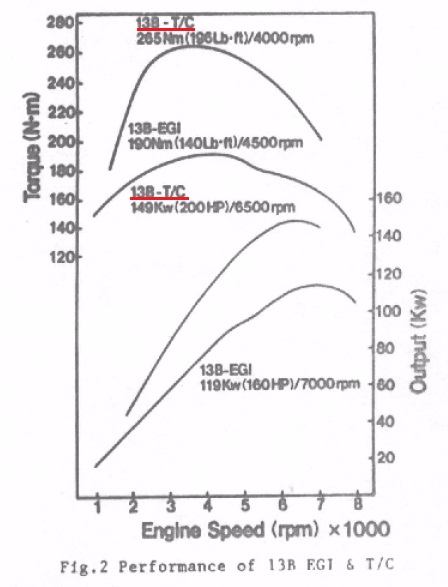
I'll be the first to admit that the graph units vary, the graph scaling varies, and the dyno itself varies. A lot of people ask "why didn't Mazda just keep a single turbo?" It doesn't seem like they could feasibly meet their goals for a broad torque band with the single turbo technology they had.
In another thread t-von posted this dynosheet (presumably from a dynojet roller dyno) he found of a stock series 6 FD. The stock FD is in red.

So let's first compare to earlier turbo rotaries. This dynosheet shows the series 3 turbo 12A engine output with the original and revised single scroll turbocharger:

And here's the series 5 Rx-7 13B turbo engine with a twin scroll single turbo. This engine was the immediate predecessor to the 13B-REW.

I'll be the first to admit that the graph units vary, the graph scaling varies, and the dyno itself varies. A lot of people ask "why didn't Mazda just keep a single turbo?" It doesn't seem like they could feasibly meet their goals for a broad torque band with the single turbo technology they had.
#2
So how does an FD dyno curve compare to other port injected turbo gas engines? Let's start by looking at contemporaneous Supra turbo engines, the sequential turbo Mark IV 2JZ-GTE engine and the Mark III 7M-GTE single turbo engine.
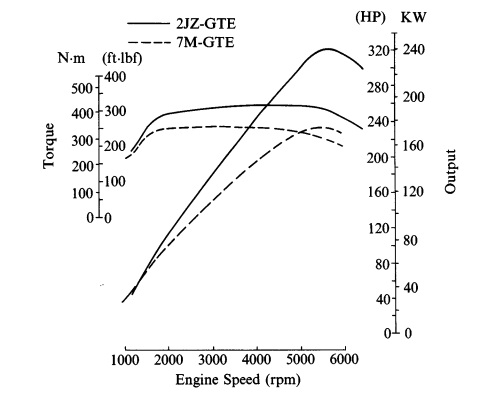
The REW revs higher than the 2JZ but from what I can see the useable torque band is equally broad between the two, although the 2JZ probably has more torque way down low. Here's another set of port injected engines:
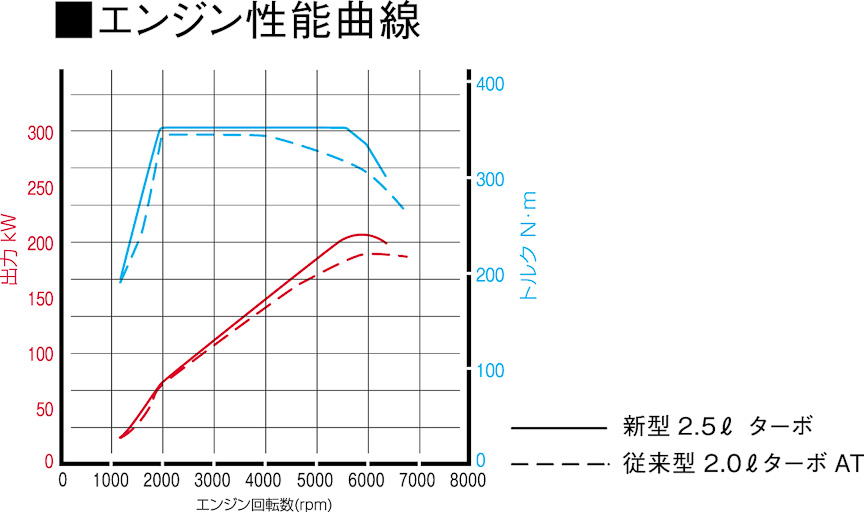
That is a manufacturer [engine] dynosheet for a 2010 Subaru Legacy 2.5 GT, which is just a turbo 4 cylinder family sedan. It uses a short runner divided manifold with single turbo to improve response. The old Subaru sequential twin turbo boxers were phased out a decade ago. The solid line is for the turbo 2.5 boxer engines in the US and the dotted line is for the 2.0 engines used in Japan. Those are port injected, but modern direct injected turbo engines tend to have even better low end torque. Here's a stock dyno sheet for a stock Evo X:
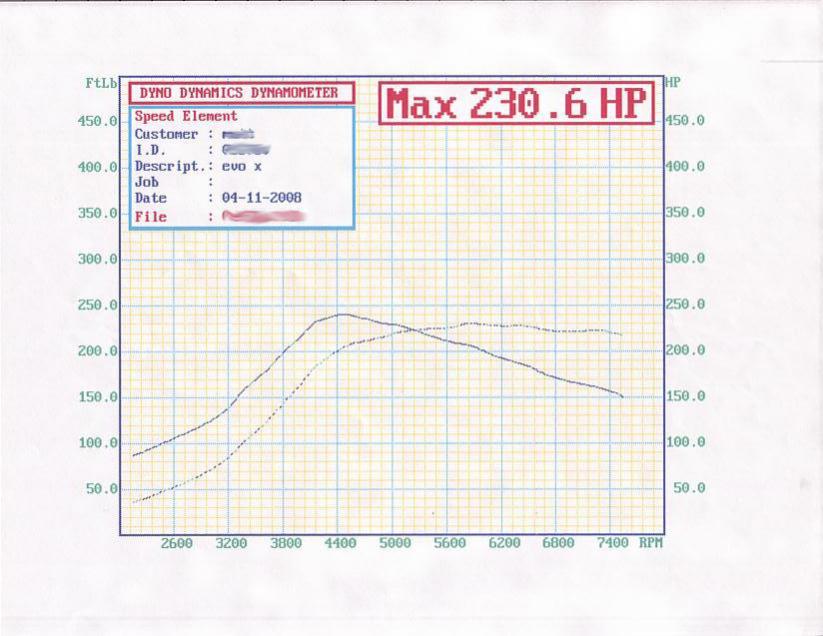
And here's a dyno sheet for a stock R35 GT-R:
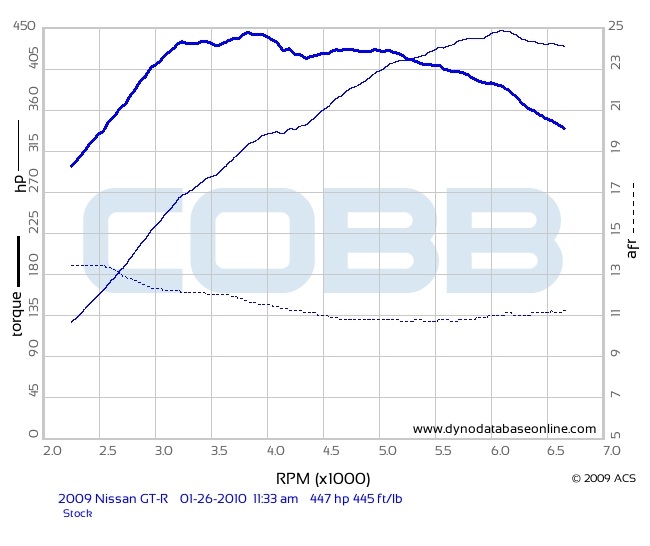

The REW revs higher than the 2JZ but from what I can see the useable torque band is equally broad between the two, although the 2JZ probably has more torque way down low. Here's another set of port injected engines:

That is a manufacturer [engine] dynosheet for a 2010 Subaru Legacy 2.5 GT, which is just a turbo 4 cylinder family sedan. It uses a short runner divided manifold with single turbo to improve response. The old Subaru sequential twin turbo boxers were phased out a decade ago. The solid line is for the turbo 2.5 boxer engines in the US and the dotted line is for the 2.0 engines used in Japan. Those are port injected, but modern direct injected turbo engines tend to have even better low end torque. Here's a stock dyno sheet for a stock Evo X:

And here's a dyno sheet for a stock R35 GT-R:

#3
Now on to some direct injected engines. Here's the 2.3 DISI Mazda engine in the Mazdaspeed 3:

Here's a stock dyno of the Ford Ecoboost twin turbo V6 engine:
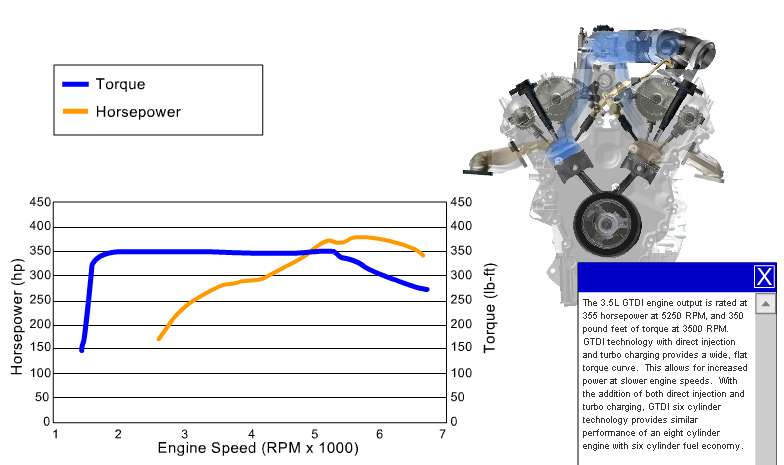
Here's a stock dyno of a BMW N54 twin turbo inline 6 engine:
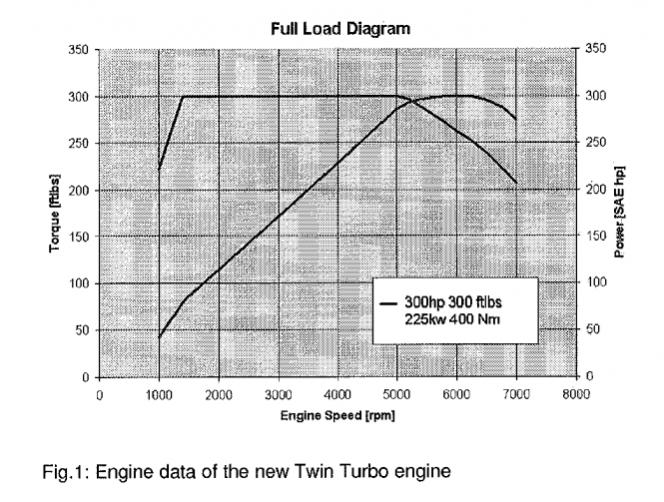
Ok that's enough dynosheets. So how does the series 6 FD engine "measure up" to other turbocharged engines? From what I've seen, the available very low end torque is adequate but nothing impressive these days. It does have a broad torque band compared to the peaky torque of the older rotaries and a hopped-up engine like the Evo X motor.
Here's a stock dyno of the Ford Ecoboost twin turbo V6 engine:

Here's a stock dyno of a BMW N54 twin turbo inline 6 engine:

Ok that's enough dynosheets. So how does the series 6 FD engine "measure up" to other turbocharged engines? From what I've seen, the available very low end torque is adequate but nothing impressive these days. It does have a broad torque band compared to the peaky torque of the older rotaries and a hopped-up engine like the Evo X motor.
#4
Senior Member
iTrader: (3)
Join Date: Sep 2004
Location: Oklahoma City
Posts: 700
Likes: 0
Received 0 Likes
on
0 Posts
You really can't compare today's engines w/ yesterdays. Look at the renesis vs the S5 N/A motor there is a huge difference. I have owned both and ran both hard no comparison. Look at what GM has done. Compare a 95 camaro w/ the new camaro, and then do the same w/ the vette. Its night and day. We can do this w/ every manufacturer. So you can't really compare the FD w/ today's standard.
I also have a speed6 w/ the 2.3 direct injected turbo motor. It may make more torque down low but is is in no way as fun as the FD. It could be the entire package in a heavier car, but it just isn't as good. My wife can vouch, she drives the 6 daily.
I really feel we are loosing the value of the FD w/ the horse power quest. It seems that today it's all about the dyno sheet to post on the internet no matter if the powerband is useable or not. Its like a dick measuring contest. I remember people enjoying the entire car and its design, setup, and package more than the fact that it makes XXX hp.
I was just at the mile and saw some stupid cars hp wise and the FD w/ the 13B just cannot compete in making the power some of those cars make. Not sure it has a chance w/ the 20B in it. But then again none of these cars are over 5 yrs old that I am talking about. That's 10yrs of advancement, and that's a lot.
I really think we should get back to enjoying a well rounded set up in one of the best sports cars made. Instead of I need XXX HP to keep the vette, 911, Viper, or the Space Shuttle in check. If you wanna make big power you have the wrong platform plain and simple. If you want one of the best rounded sports car ever made that w/ a few mods can perform amazingly in today,s market then I would say the FD is perfect. Otherwise get something else.
Post all the graph's you want, but those will never tell you how the car feels as you row through the gears. And this is what its really about.
I also have a speed6 w/ the 2.3 direct injected turbo motor. It may make more torque down low but is is in no way as fun as the FD. It could be the entire package in a heavier car, but it just isn't as good. My wife can vouch, she drives the 6 daily.
I really feel we are loosing the value of the FD w/ the horse power quest. It seems that today it's all about the dyno sheet to post on the internet no matter if the powerband is useable or not. Its like a dick measuring contest. I remember people enjoying the entire car and its design, setup, and package more than the fact that it makes XXX hp.
I was just at the mile and saw some stupid cars hp wise and the FD w/ the 13B just cannot compete in making the power some of those cars make. Not sure it has a chance w/ the 20B in it. But then again none of these cars are over 5 yrs old that I am talking about. That's 10yrs of advancement, and that's a lot.
I really think we should get back to enjoying a well rounded set up in one of the best sports cars made. Instead of I need XXX HP to keep the vette, 911, Viper, or the Space Shuttle in check. If you wanna make big power you have the wrong platform plain and simple. If you want one of the best rounded sports car ever made that w/ a few mods can perform amazingly in today,s market then I would say the FD is perfect. Otherwise get something else.
Post all the graph's you want, but those will never tell you how the car feels as you row through the gears. And this is what its really about.
#5
Senior Member
Join Date: Nov 2008
Location: Czech republic
Posts: 357
Likes: 0
Received 0 Likes
on
0 Posts
While this to certain extent holds true, we still can compare it to turbo engines from same time. And when you look at graphs of 2JZ and 7M, or even some single turbo engines even with less capacity, it can be clearly seen, that REW twins doesn´t deserve so much hype Its so called flat torque band is simply lack of midrange boost - and this is what can make car really fast.
Its so called flat torque band is simply lack of midrange boost - and this is what can make car really fast.
When I look at good old Best Motoring videos, from my point of view, it seems that stock FD is always lacking on corner exit and straight line, despite having better power/weight ratio.
The question arises whether Mazda done it purely for marketing reasons. If one turbo is good, two must be better, right?
 Its so called flat torque band is simply lack of midrange boost - and this is what can make car really fast.
Its so called flat torque band is simply lack of midrange boost - and this is what can make car really fast.When I look at good old Best Motoring videos, from my point of view, it seems that stock FD is always lacking on corner exit and straight line, despite having better power/weight ratio.
The question arises whether Mazda done it purely for marketing reasons. If one turbo is good, two must be better, right?
#6
You really can't compare today's engines w/ yesterdays. Look at the renesis vs the S5 N/A motor there is a huge difference. I have owned both and ran both hard no comparison. Look at what GM has done. Compare a 95 camaro w/ the new camaro, and then do the same w/ the vette. Its night and day. We can do this w/ every manufacturer. So you can't really compare the FD w/ today's standard.
I also have a speed6 w/ the 2.3 direct injected turbo motor. It may make more torque down low but is is in no way as fun as the FD.
I really feel we are loosing the value of the FD w/ the horse power quest. It seems that today it's all about the dyno sheet to post on the internet no matter if the powerband is useable or not. Its like a dick measuring contest.
Post all the graph's you want, but those will never tell you how the car feels as you row through the gears.
I'm sure there is a marketing element to it. But considering the vast improvement in the torque band between the single twin scroll turbo of the series 5 engines and the series 6 sequential turbos, it seems like a cost-conscious single turbo (no exotic manufacturing process) would not have met their needs.
#7
Exactly! People often forget that it's not so much a tall order for manufacturers to engineer an engine to product a specific amount of torque over a smallish rev range. Notice how most of those dynos above are barely holding torque past 6,000 rpms? With the rotary, you have a bigger and more challenging rev range to engineer your set-up around. It's just like I said in the other thread. For what Mazda did 20 years ago was something truly special. Personally the only other way Mada could improve, is to go the Porsche route with their variable geometry set-up.
Trending Topics
#8
Moderator
iTrader: (3)
Join Date: Mar 2001
Location: https://www2.mazda.com/en/100th/
Posts: 30,796
Received 2,574 Likes
on
1,830 Posts
Exactly! People often forget that it's not so much a tall order for manufacturers to engineer an engine to product a specific amount of torque over a smallish rev range. Notice how most of those dynos above are barely holding torque past 6,000 rpms? With the rotary, you have a bigger and more challenging rev range to engineer your set-up around. It's just like I said in the other thread. For what Mazda did 20 years ago was something truly special. Personally the only other way Mada could improve, is to go the Porsche route with their variable geometry set-up.
and it kind of went away until i guess the porsches?
#9
Banned. I got OWNED!!!
Join Date: Mar 2009
Location: NC
Posts: 1,045
Likes: 0
Received 0 Likes
on
0 Posts
#10
I'm sure Mazda has tried variable vane turbos on rotaries in their labs before. The problem is the exhaust temperature of the rotary could affect longevity of the turbo. Perhaps they also had boost control issues. Remember that variable vane turbos don't have wastegates. They basically increase the internal A/R so much that boost no longer increases. Well we all know how much rotaries like big A/R turbine housings.
Thread
Thread Starter
Forum
Replies
Last Post
trickster
2nd Generation Specific (1986-1992)
25
07-01-23 04:40 PM
KAL797
Test Area 51
0
08-11-15 03:47 PM



